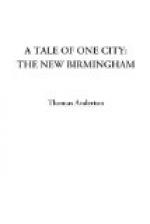Sandwell Park—ah, yes, I have a pretty distinct recollection of what that was, also the Hall, in my boyhood days. The park, or portions of it, still shews some signs of its past picturesque glories; at any rate, it is not built over after the manner of Aston. The Hall, however, scarcely now conveys an idea of the place it once was. I remember its interior when it was the residence of its noble owner and his family, and I recall the splendidly furnished rooms, the riding school, and the gardens. I remember, too, that the Lord Dartmouth of the time of which I speak was, like Mr. Gladstone, an amateur woodman. He used to like to go about with axe and saw, and do a little tree felling and branch lopping to please his fancy, and exercise his limbs and muscles. Sandwell Park, as most people know, has now been deserted for many years by its titled owner, and Sandwell Park Colliery, Limited, reigns in its stead.
But recollections of the past are making me “talky,” and, I fear, tedious. I could scribble and chatter about bygone Birmingham from now till about the end of the century, which, however, as I write, is not very far off. But, my gentle reader, you shall be spared. Most people know that Birmingham is swallowing up its immediate suburbs, and the process of deglutition is still going on. The city has had its rise, and will have its decline some day probably, but not while people want pins, pens, electro-plate, guns, dear and cheap jewellery, and while Birmingham can make these things better or sell them cheaper than other folks.
As for the centre of the city, I have already made some references to the transformations that have recently taken place. A few words may, however, be said about our modern street and shop architecture. In the important new thoroughfare, Corporation Street—the outcome of Mr. Chamberlain’s great improvement scheme—there is a curious series of shops and public buildings. Some are of one style, some of another, and many of no style at all. The architecture in this thoroughfare certainly presents plenty of variety—more variety perhaps than beauty. There are the new Assize Courts—the foundation-stone of which was laid by the Queen in 1887; they are built of brick and terra-cotta, redundant with detailed ornament, some of it perhaps of a too florid character. Near to our local Palace of Justice is the County Court, which is severe in its simplicity, quasi-classic in style, and decidedly plain in design. There are shops that have a certain suggestion and imitation of old-fashioned quaintness, and there are other buildings that have a tinge of the Scotch baronial hall style of architecture. Then there is the coffee-house Gothic, the pie-shop Perpendicular, the commercial Classic, the fender and fire-grate Transitional, the milk and cream Decorated, and various hybrid architectural styles.




